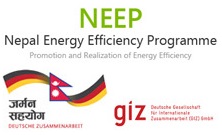Overview
Cogeneration or combined heat and power (CHP) is the describing the process of simultaneously generation of electricity and heat. Cogeneration can mean (1) the production of electricity using waste heat from an industrial process or (1) the use of steam from electric power generation as a source of heat.
In the context of Nepal and the cogeneration opportunities for industries, the production of electricity from waste heat is meant. Any fuel (coal, husk, bagasse or furnace oil), as an energy source, has the chemical energy which can produce any of the following:
- Hot Water at 70-90˚C (very low energy content)
- Low pressure and temperature steam (Low energy content)
- Medium pressure and temperature steam (Medium energy content)
- High Pressure and superheated steam (High energy content)
Process of cogeneration
The industry as a user normally meets process heat energy needs by producing Hot Water, Low pressure, Low temperature steam, Medium pressure and Medium temperature steam, or High pressure and super heated steam while electrical energy needs for drives and illumination are met by grid or diesel based electricity.
The Industry has the choice to meet its heat energy and electrical energy, the above conventional way, or, more efficiently, and at lower overall cost, through cogeneration.
Here, same fuel is used first to produce high energy content steam (high pressure and superheated), which is led into a steam turbine, to produce by-product electricity, while low pressure and low temperature tail-end steam (called back pressure or extraction steam) at the turbine exit, is used to meet the process heat energy requirements. The word cogeneration thus relates to simultaneous generation of heat (steam) and power.
Generating steam at higher pressure and temperature in a cogeneration system, adds just 10 to 20% on the fuel costs, but economical by-product electrical energy is produced enhancing overall energy efficiency significantly.
In steam based cogeneration systems, back pressure turbines are deployed, where high pressure, often superheated steam from efficient boilers, is expanded in a turbine to generate power, and back pressure exhaust steam is utilized for process requirements. Higher the inlet pressure and temperature, higher the power output and likewise, lower the back pressure, higher the power output.
Figure 1: Process diagram of Cogeneration in sugar industry (Quaintenergy.com, 2014)
The key factors influencing industrial cogeneration economics include capacity utilization, process steam demand, pressure variations, Power demand pattern, turbine Inlet steam parameters, turndown ratio and efficiency of boiler and turbo generator, auxiliary power consumption, fuel and power costs prevalent, stand-alone or grid linked operations.
Benefits of Cogeneration
Estimates indicate that a significant proportion of current electricity generation in Nepal could be met by bagasse-based cogeneration in the sugar industry. Biomass Cogeneration plants uses agricultural residue, e.g., bagasse (biomass residue from sugar cane production) as primary fuel. This approach allows sugar mills and other biomass generating industries to be energy independent, while at the same time export energy to the grid and reduce load shedding hours.
With Wide variety of cogeneration schemes and innovations for process industry to choose from, cogeneration offers a win-win situation, be it for a rice mill/small process industry, paper mill, sugar unit, a cement plant, or even for steam throttling avoidance, wherever steam/heat and power are simultaneously needed.
The cogeneration benefits are economy for end user, and many times, where by-product power is sold to grid, alleviation of shortfalls for utilities, and above all, avoidance of costly diesel imports, which affect economy of the nation, at large.



